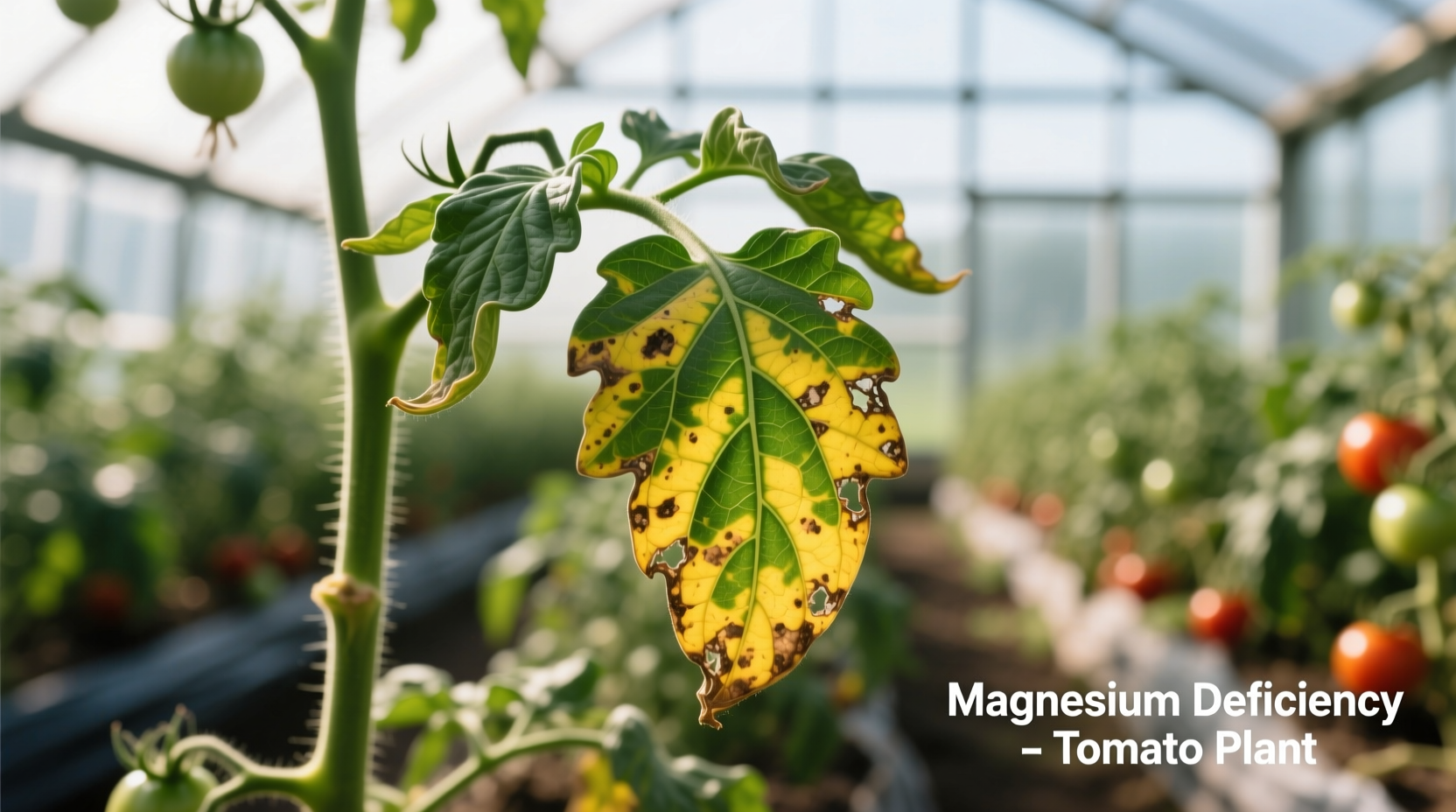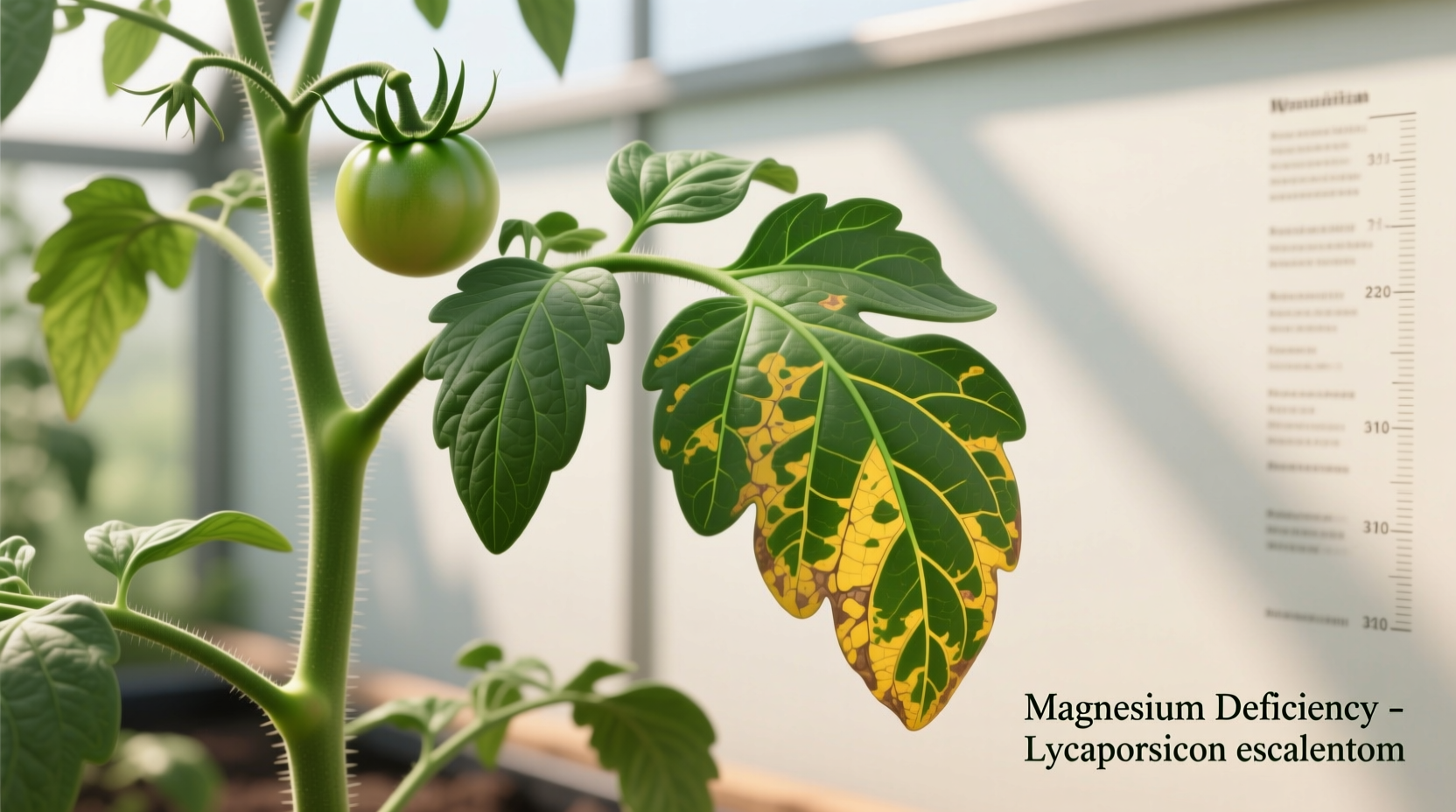Spotting Magnesium Deficiency: Your First Diagnostic Step
When your tomato plants develop yellow leaves but the veins stay green, you're likely dealing with magnesium deficiency. This common gardening issue affects tomato growers worldwide, particularly in acidic soils or container gardens. Unlike nitrogen deficiency which starts on older leaves with uniform yellowing, magnesium deficiency shows as interveinal chlorosis—yellow patches between the veins while the veins themselves remain distinctly green.
As magnesium is a mobile nutrient in plants, deficiency symptoms always appear first on older, lower leaves. If left untreated, the yellowing spreads upward through the plant, eventually causing leaf drop and reduced fruit production. In severe cases, you might notice purple discoloration on leaf undersides and stunted growth.
| Nutrient Deficiency | Initial Symptoms | Leaf Pattern | Progression Direction |
|---|---|---|---|
| Magnesium | Yellowing between veins | Interveinal chlorosis, green veins | Older to newer leaves |
| Nitrogen | Uniform yellowing | Entire leaf yellowing | Older to newer leaves |
| Iron | Yellowing between veins | Interveinal chlorosis on new growth | Newer to older leaves |
| Sulfur | Uniform pale green | Entire leaf lightening | Newer to older leaves |
According to the University of California Agriculture and Natural Resources, magnesium deficiency in tomatoes becomes problematic when soil magnesium levels fall below 25 ppm (parts per million). Their research shows that tomato plants require consistent magnesium availability throughout their growth cycle, especially during fruit set.
Why Magnesium Deficiency Happens in Tomato Plants
Several factors contribute to magnesium deficiency in tomatoes, often working in combination:
- Acidic soil conditions (pH below 5.5) reduce magnesium availability
- Excessive potassium in soil blocks magnesium uptake
- Poor soil structure in container gardens or raised beds
- Heavy rainfall leaching magnesium from soil
- High calcium levels competing with magnesium absorption
The Cornell University Cooperative Extension notes that magnesium deficiency frequently occurs in sandy soils and container gardening situations where nutrients wash out quickly. Their field studies show container-grown tomatoes are 3.2 times more likely to develop magnesium deficiency than those in garden beds.
Immediate Treatment: Fixing Magnesium Deficiency Fast
When you spot magnesium deficiency symptoms, act quickly with these proven solutions:
Epsom Salt Solution (Most Effective Quick Fix)
Mix 1 tablespoon of Epsom salt (magnesium sulfate) per gallon of water. Apply as either:
- Foliar spray: Mist both sides of affected leaves (best done early morning)
- Soil drench: Pour around base of plant (1 gallon per mature tomato plant)
You should see improvement within 48-72 hours as the green color returns to yellowed areas. Repeat applications every 2 weeks until symptoms disappear, then monthly for prevention.

Important Application Tips
- Never exceed 2 tablespoons per gallon—too much can cause salt burn
- Apply in cool temperatures to prevent leaf scorch
- Combine with a light soil aeration to improve absorption
- Avoid spraying during peak sun hours
Long-Term Soil Correction: Preventing Recurrence
While Epsom salt provides quick relief, addressing the underlying soil issues prevents future magnesium problems:
Soil Testing First
Before making major soil amendments, conduct a proper soil test. The USDA Natural Resources Conservation Service recommends testing every 2-3 years to monitor nutrient levels. Your test should specifically check:
- Soil pH level
- Magnesium concentration (ppm)
- Calcium-to-magnesium ratio
- Potassium levels
Dolomitic Lime Application
For acidic soils (pH below 6.0), apply dolomitic lime which contains both calcium and magnesium:
- Rate: 5 pounds per 100 square feet for moderate correction
- Timing: Apply 2-4 weeks before planting
- Mix thoroughly into top 6-8 inches of soil
Dolomitic lime works slower than Epsom salt but provides season-long magnesium availability and corrects pH simultaneously.
Organic Matter Improvement
Incorporate magnesium-rich organic materials:
- Composted manure (particularly from animals fed magnesium-rich diets)
- Epsom salt-enriched compost (1 cup per cubic yard of compost)
- Seaweed extracts (naturally high in magnesium)
- Wood ash (contains magnesium carbonate)
Monitoring and Maintenance Schedule
Track your tomato plant's recovery with this timeline:
| Time After Treatment | Expected Improvement | Action Required |
|---|---|---|
| 24-48 hours | Yellowing stops spreading | Monitor for leaf burn |
| 3-5 days | Green color returns to veins | Second application if needed |
| 7-10 days | New growth appears healthy | Reduce frequency to maintenance |
| 2-3 weeks | Full recovery on treated leaves | Preventative monthly application |
Prevent magnesium deficiency in future seasons by maintaining soil pH between 6.0-6.8 and ensuring proper calcium-magnesium balance. The ideal calcium-to-magnesium ratio in soil should be approximately 4:1 to 7:1 for optimal tomato growth.
When Magnesium Isn't the Problem
Be cautious not to misdiagnose other issues as magnesium deficiency. Similar symptoms can indicate:
- Herbicide damage from drift (causes irregular yellow patterns)
- Viral infections like tomato yellow leaf curl virus
- Root damage from overwatering or pests
- Iron deficiency which affects new growth first
If Epsom salt treatments show no improvement after 10 days, consider these alternative causes. The Cornell University Cooperative Extension reports that 22% of suspected magnesium deficiency cases are actually root system issues unrelated to nutrient levels.
Practical Prevention Strategies for Next Season
Implement these practices to prevent magnesium deficiency before it starts:
- Test soil pH before planting and amend as needed
- Avoid excessive potassium fertilizers which compete with magnesium
- Incorporate dolomitic lime during fall soil preparation
- Use balanced organic fertilizers with magnesium content
- Mulch with magnesium-rich materials like composted seaweed
- Rotate tomatoes with magnesium-accumulating cover crops like buckwheat
Remember that container-grown tomatoes require more frequent magnesium monitoring as nutrients leach out with regular watering. For container plants, include Epsom salt in your regular feeding schedule at half-strength (1/2 tablespoon per gallon) every 4-6 weeks.
Tomato Magnesium Deficiency FAQ
Here are answers to common questions about magnesium deficiency in tomatoes:











 浙公网安备
33010002000092号
浙公网安备
33010002000092号 浙B2-20120091-4
浙B2-20120091-4